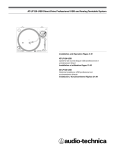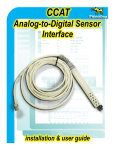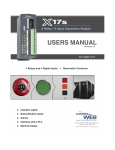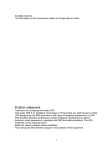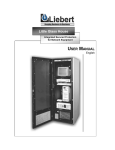Download Audio-Technica AT-PL120 audio turntable
Transcript
Direct Drive Professional Stereo Turntable AT-PL120 Installation and Operation Direct Drive Professional Stereo Turntable Installation and Operation Warning: To prevent fire or shock hazard, do not expose this appliance to rain or moisture. Attention: Pour prévenir feu ou choc électrique, ne pas exposé l’appareil à la pluie ou à l’humidité. Cuidado: Para evitar descargas eléctricas o el peligro de incendio, no exponga este aparato a la lluvia o humedad. Introduction Thank you for purchasing the AT-PL120. Audio-Technica has been a leading manufacturer of innovative stereo phonograph products for more than 40 years. We are pleased to provide this turntable, with its excellent performance and many convenient features, for your enjoyment. The AT-PL120 stereo turntable system features the following: • Direct drive high-torque motor CAUTION RISK OF ELECTRIC SHOCK DO NOT OPEN AVIS RISQUE DE CHOC ÉLECTRIQUE NE PAS OUVRIR PRECAUCION: RIESGO DE DESCARGAS ELECTRICAS NO SE ABRA To prevent electric shock, do not remove the cover. There are no user-serviceable parts inside. Internal adjustments are for qualified professionals only. Refer all servicing to qualified service personnel. Pour prévenir un choc électrique, ne pas ouvrir le couvercle. Il n’y aucune pièces de rechanges à l’intérieur. Tout ajustement interne doit être fait par une personne qualifié seulement. Référez tout réparation au personnel qualifié. Para reducir el riesgo de descargas eléctricas, no se abra la cubierta. No existen partes de reemplazo para que el usuario pueda reparar por dentro el aparato. Deje cualquier clase de mantenimiento en manos de técnicos especializados. • Selectable 33/45/78 rpm speeds • Selectable internal stereo phono pre-amplifier • S-shaped tone arm assembly with: • Adjustable counterweight • Anti-skate adjustment • Tone arm height adjustment and lock • Tone arm lift with hydraulic action and lift lever • Tone arm rest with locking mechanism • Selectable high-accuracy quartz-controlled pitch lock • Selectable +/–10% or +/– 20% pitch adjustment ranges • Stroboscopic platter speed indicator • Forward and reverse play • Cast aluminum record platter with slip mat • Start/stop button with remote start/stop input • Pop-up stylus target light • 45-rpm adapter with storage receptacle • Receptacle for extra headshell Caution: To prevent electric shock, do not use the polarized plug with an extension cord, receptacle, or other type of electrical outlet unless the wide blade can be easily inserted into a matching slot. Attention: Pour éviter toute décharge électrique, ne pas utiliser la prise polarisée avec un cordon de prolongation, réceptacle ou tout autre dispositif électrique, à moins que la broche large puisse s’insérer facilement dans un trou de même taille. Precaución: Para evitar descargas eléctricas, no use clavijas polarizadas con una extension de cable, receptáculo, u otro tipo de toma eléctrica a menos que el conductor plano más ancho de la clavija pueda insertarse facilmente en el ranura del enchufe que le corresponde. 2 • Adjustable feet for leveling • Removable hinged dust cover To assure maximum satisfaction from this product, please read the information and follow the instructions presented in this manual. Please keep the manual in an accessible location for future reference. We suggest that you save all the packaging materials for possible future storage, moving, or shipping. Caution: To avoid stylus damage, make certain the included stylus guard is in place whenever the turntable is being installed, moved, or cleaned. Main Features Figure 1 Main Features 8 8 18 9 7 PHONO OUT LINE OUT 10 11 17 115 12 13 1 2 3 4 5 6 1. Power Dial Controls power to the unit. 2. Start/Stop Button Engages and disengages the motor/platter. 3. Platter Speed Buttons Select 33 or 45 RPM platter speed. (Note: 78 RPM is selected by pressing the 33 and 45 buttons simultaneously.) 4. PLATTER Cast aluminum platter mounts directly to center spindle/motor shaft. 5. Strobe Dots (On platter edge) Operate in conjunction with stroboscopic light located under power dial (1) to provide visual indication of accurate platter speeds. 16 15 14 11. DIRECTION BUTTON Controls platter’s rotational direction: F – Forward (clockwise) R – Reverse (counter-clockwise) 12. PITCH ADJUST SLIDE CONTROL Use in conjunction with pitch button (15) to vary the platter’s rotational speed. In the center detent position quartz lock is active. 13. PITCH SELECTION INDICATOR Shows Green for standard or locked RPM setting, or Red for a pitch-adjusted setting. 14. QUARTZ SPEED LOCK Toggles between internal quartz-locked reference and variable pitch controlled by pitch adjust slide control (12). 6. CENTER SPINDLE Precision-machined platter mount on motor shaft. 15. 7. 45-RPM ADAPTER (Shown in receptacle) Adapts 7” records with large center holes to fit center spindle. 16. POPUP STYLUS TARGET LIGHT Provides illumination directed at the stylus position for easier cueing in poor light. 8. DUST COVER HINGE HOLDERS Attachment points for removable hinged dust cover. 17. VOLTAGE SELECTOR SWITCH (Access through holes in platter) Selects operating voltage (115V or 230V AC, 50/60 Hz). 9. HEADSHELL RECEPTACLE Storage receptacle for extra headshell (not included). 10. TONE ARM ASSEMBLY Refer to Figure 2 on page 4 for details. PITCH BUTTON Selects the range of pitch variation permitted by the pitch adjust slide control (12). (See page 7 for information on locking or adjusting platter speed.) 18. PRE-AMP SELECTOR SWITCH (Access through holes in platter) Allows the internal stereo phono pre-amp to be bypassed when the turntable is used with equipment having magnetic phono inputs. 3 Tone Arm Assembly Diagram Figure 2 Tone Arm Assembly 29 19. HEADSHELL Standard, interchangeable stereo cartridge headshell. 28 20. 27 HEADSHELL LOCKING RING Rotate counter-clockwise (to the left) to draw the inserted headshell firmly into its seated, locked position. Rotate the ring a full turn to the right to permit removal of the headshell. 26 25 21. TONE ARM S-shaped tone arm geometry reduces tracking error. 22. 24 TONE ARM ASSEMBLY HEIGHT ADJUST Raises and lowers the entire tone arm assembly to allow the tone arm to remain parallel to the record surface. (The proper setting is “0” for the included cartridge.) 23 22 23. Tone Arm Lift Elevates tone arm above record surface. 24. TONE ARM REST WITH LOCKING CLAMP Locking clamp secures tone arm during transport. 25. TONE ARM LIFT ADJUST SCREW Used to set the amount of tone arm lift. 21 26. TONE ARM LIFT CONTROL LEVER (“Cueing Lever”) Controls action of tone arm lift. (Note: Lift mechanism is hydraulically damped to slow tone arm descent.) 27. ANTI-SKATE CONTROL Applies a small inward force to the tone arm, counteracting the tendency of the tone arm to move outward due to forces created by the stylus in the record groove. 20 19 28. COUNTERWEIGHT Balances the tone arm and provides adjustment for proper downward tracking force on the stylus. 29. TONE ARM ASSEMBLY HEIGHT LOCK (Hidden under counterweight in drawing) Locks the tone arm height setting. (Always fully unlock before attempting to make a height adjustment.) Rear View Diagram Figure 3 Rear View of Turntable 30. REMOTE START/STOP (1/ ” jack) This 1/ ” jack (2 conductor Tip/Sleeve) provides a normally open dry-contact closure that allows for remote start/stop of platter. 4 4 PITCH 30 OUTPUT 4 REMOTE START/STOP Initial Setup Unpacking Carefully unpack the turntable and verify that the following parts are included and intact: • Slip mat (above the dust cover) • Dust cover (above the turntable) • Platter (under the turntable) • Dust cover hinges (accessory section of the foam packaging) • 45 RPM adapter (accessory section) • Counterweight (accessory section) • Headshell with pre-mounted cartridge (accessory section) • Power cord (accessory section) WE RECOMMEND THAT YOU SAVE ALL PACKAGING MATERIALS FOR POSSIBLE FUTURE STORAGE, MOVING OR SHIPPING. Assembling the Turntable The AT-PL120 requires some assembly before first use. IMPORTANT: Do not connect the AC power cord until assembly is complete. Setting the Voltage Selector Switch This turntable has the capability to be used with either 115V or 230V AC power, 50/60 Hz. The voltage selector switch is located on the top of the housing deck, under the platter. Set the switch according to the voltage in your area. [See Figure 4.] (Note: The turntable comes shipped with the voltage selector switch set for 115V AC.) Figure 4 Voltage Switch and Pre-amp Selector Switch Pre-amp Selector Switch Voltage switch pre-amp selector switch to the PHONO OUT position and connect the turntable’s output cables to the PHONO inputs on your system, observing Red for Right channel and White for Left channel. If your system does not have a PHONO (magnetic phono) input, set the pre-amp selector switch to LINE OUT and connect the turntable’s output cables to the Auxiliary (AUX) or other high-level inputs on your system, observing Red for Right channel and White for Left channel. When using the turntable with a computer sound card, set the switch to LINE OUT and connect the turntable to the audio line input on the computer sound card. Note: An audio adapter (not included) may be required to interface the two RCA jacks of the turntable output cable to the computer sound card input. Assembling the Tone Arm (Note: The headshell and cartridge are supplied pre-assembled with the AT-PL120.) 1. Remove the vinyl tie used to secure the tone arm during shipment. Temporarily secure the tone arm in the tone arm rest with the locking clamp. [Figure 2, page 4, #24.] 2. Attach the headshell assembly by inserting it into the socket at the front of the tone arm [See Figure 5.] (It’s good practice always to hold a headshell assembly by the left and right edges of the headshell to reduce the possibility of damaging the stylus or disrupting the cartridge wiring.) 3. While holding the headshell in position, rotate the headshell locking ring counter‑clockwise (to the left). As the ring turns, it pulls the headshell into its seated position. (Rotate the ring a full turn to the right to permit removal of the headshell.) 4. With its black dial toward the front, use a screwing motion to attach the counterweight to the arm extending back from the tone arm pivot [Figure 2, page 4, #28]; the counterweight will engage the spiral groove in the rear arm section and move forward. Figure 5 Headshell Setting the Pre-amp Selector Switch For increased flexibility of use, this turntable has an internal stereo phono pre-amplifier. The pre-amp selector switch located in the rear-center of the housing deck under the platter [See Figure 4], selects the internal stereo pre-amplifier (LINE OUT), or bypasses the pre-amp (PHONO OUT) for use with systems having specialized magnetic phono input jacks. The audio output cable’s Red RCA-type plug is the Right channel; the White plug is the Left channel. If the system you are using has a PHONO input, set the 5 Initial Setup (continued) Assembling the Turntable Platter and Slip Mat 1. Carefully place the turntable platter on the center spindle, making certain the platter is fully seated on the spindle. [See Figure 6.] 2. Place the soft black slip mat on top of the platter. Figure 6 Platter and Slip Mat Assembling the Dust Cover 1. Insert the T-shaped ends of the dust cover hinges into the two hinge receptacles located at the back of the turntable housing. When properly installed, the flat part of the cover hinges should be facing away from the turntable housing at about a 45° angle. 2. Holding the dust cover over the turntable, carefully guide the cover hinges into the two slots molded into the rear of the dust cover. The springs in the hinges allow the cover to be held open at about a 45° angle if desired. (Note: There is only one “open” position; the hinges do NOT permit the cover to stand “straight up.”) 3. To remove the dust cover from the turntable, gently disengage the hinges from the slots in the cover. This is usually easier when the cover is in the “closed” position. Slowly and carefully lift straight up until the cover is clear of the unit. The hinges may then be removed from the turntable base, if desired. Setting Tone Arm Balance and Tracking Force To allow the cartridge to properly track in a record, the tone arm balance and tracking force must be carefully set to the cartridge manufacturer’s specifications. Failure to properly set up the tone arm assembly can cause damage to the cartridge stylus and/or records. (Note: Once the stylus protective cover has been removed and the tone arm locking clamp has been released, take extreme care not to damage the stylus. Do not allow it to drag or scrape across the slip mat.) Tone Arm Setup: 1. Set the anti-skate adjustment to “0”. [Figure 2, page 4, #27.] 2. Remove the clear protective stylus cover, carefully sliding it straight forward, off the front of the cartridge. 3. While gently holding the headshell to stabilize the tone arm, release the tone arm locking clamp. At this point, the tone arm is unbalanced and free to swing. 4. 6 While gently holding the headshell, carefully rotate the counterweight until the tone arm is horizontally balanced and hovers freely just above the platter without touching the platter surface. 5. Lock the tone arm back into the tone arm rest. 6. While holding the counterweight steady, and without any rotation, carefully rotate only the black stylus force gauge ring (which turns independently of the counterweight) until the “0” on the gauge ring lines up with the centerline marked along the top of the rear arm. 7. Refer to the cartridge manufacturer’s specifications for recommended tracking force. Rotate the entire counterweight counterclockwise without touching the black gauge ring, moving the counterweight forward, until the desired value on gauge ring lines up with the centerline marked on the rear arm. Refer to the specifications section for tracking force value for the cartridge that shipped with the turntable. Setting Anti-skate A small inward “anti-skating” force can be applied to the tone arm to compensate for outward forces resulting from cartridge/ tone arm interaction with the record. For best performance during normal turntable use, set the anti-skate control knob [Figure 2, page 4, #27] to the same setting as the tracking force dial. Refer to the specifications section for tracking force value of the cartridge that shipped with the turntable. In case of substantial use of back-cueing, scratching or reversedirection operation, you may prefer to use less, or no, anti-skate compensation. Setting Tone Arm Assembly Height The tone arm assembly height adjustment allows for the tone arm to be positioned parallel to the record surface, when using extra-tall cartridge bodies, thick slip mats or thick records (i.e. old 78’s). To raise or lower the tone arm assembly: First, loosen the height lock [Figure 2, page 4, #29]; then rotate the height adjust dial [Figure 2, page 4, #22] located at the base of the tone arm assembly. The scale is calibrated in millimeters (mm). When finished, tighten the height lock to secure the adjustment. Connections Audio Connect the audio output cable to the appropriate input jacks on your mixer, amplifier, soundcard or other device based on the setting of the pre-amp selector switch. Firmly connect the Red RCA-type plug to the right channel input and the White RCA-type plug to the left channel input. (Note: Adapter plugs might be required to connect the turntable to computer sound cards and other devices.) Remote Start/Stop If desired, connect an appropriate cable (1/ ” 2- conductor T/S phone plug) between the remote start/stop output [Figure 3, page 4, #31] and mixing/control equipment that supports the remote start/stop function. (Note: This connection is a drycontact closure and could be wired to an external normally open switch if desired for DJ or broadcast applications.) Closing the contact closure starts the platter rotating; opening the closure stops it. The start/stop button will override the contact closure. 4 Pitch Output If desired, connect an appropriate cable (RCA-type plug) between the pitch output [Figure 3, page 4, #30] and other equipment that supports the pitch data function. This signal can be used to synchronize the turntable pitch with certain mixers, CD players and other external devices. Finally, after all other connections are made, attach the included AC power cord to the turntable; note that the small connector only goes in one way. Then connect the power cord’s plug to a convenient AC outlet. Operation For best results, do not install or operate this unit near conditions of heat, moisture, dust, or heavy vibrations. (Note: Bright fluorescent lights may affect the visibility of the speed-indicating strobe dots. If this is a problem, simply cover the area with your hand, an album cover, etc.) Preparing to Play 1. Remove the stylus guard from the stylus assembly and unlock the tone arm rest if it is locked. 2. Turn the power dial to the ON position. The speed selector and strobe illuminator will light up. 3. If desired, push the stylus target light button to raise and turn on the light for illumination of the stylus tip position on the record. 4. Place a record on the slip mat, lining up its center hole with the center spindle. For 45 RPM records, place the 45 RPM adapter on the center spindle before placing the record on the platter. 5. Set the platter rotation speed (33/45/78) to match that of the record. (Note: To set the platter speed for 78 RPM, push both the 33 and 45 RPM buttons simultaneously.) Playing the Record 1. Press the start/stop button; the platter begins to rotate. 2. Raise the tone arm by lifting the tone arm lift control lever to the UP position. 3. Position the tone arm over the desired location (groove) on the record. 4. Lower the tone arm by moving the tone arm lift control lever to the DOWN position. The tone arm descends slowly onto the record and play begins. – or – Use the finger-lift on the headshell assembly to position the tone arm over the desired location on the record. Carefully lower the tone arm to the record surface. Checking and Adjusting Pitch 1. If desired, select a +/– 10% or +/– 20% pitch adjustment range by pressing the pitch button. Then move the pitch adjust slide control up or down to make pitch adjustments. (Note: The pitch adjust slide control has center detent position for 0% pitch variation.) 2. As illuminated by the red light coming from beneath the power dial, observe the strobe dots on the edge of the platter. If the appropriate row of strobe dots appears to be stationary, the platter is moving at the precise rated speed. If the dots appear to be moving to the right, the platter is moving below rated speed; if they appear to be moving to the left, the platter is moving above rated speed. 50Hz 3. 33 45 60Hz 33 45 If the quartz speed lock button is pressed, the internal quartz lock will hold the platter at precise rated speed regardless of the position of the pitch adjust slide control. (Note: The LED indicator to the left of the pitch adjust slide control’s center position will illuminate GREEN when the quartz lock is active and RED when variable pitch is active.) 4. If desired, press the direction button to reverse the rotation of the platter. The appropriate direction LED will illuminate. Suspending or Ending Play 1. To suspend play, lift the tone arm with the cueing lever. 2. When play is finished, raise the cueing lever, move the tone arm to the rest position and secure the tone arm with the tone arm locking clamp. 3. If using the stylus target light, turn it off by pushing the light down. 4. Press the start/stop button to apply the brake and stop the platter rotation. 5. Turn the power dial to the OFF position. 7 Replacing the Stylus Replacing the Stylus The AT-PL120 comes supplied with a high-quality Audio-Technica ATP-2 cartridge. The stylus should be replaced with a genuine Audio-Technica ATP-N2 stylus. 1. Release the headshell assembly from the tone arm by turning the locking ring clockwise. 5. Gently push the stylus onto the cartridge body, being careful not to damage the stylus. The stylus assembly should click into place. 6. Replace the headshell assembly on the tone arm and secure with the locking ring. Figure 7 Removing the Stylus 2. Carefully remove the headshell assembly and turn it over so the stylus is visible. 3. Remove the stylus assembly by pulling it away from the cartridge body at a slight angle. [See Figure 7.] 4. Remove the replacement stylus from its package and carefully align it with the cartridge body. Replacing the Cartridge Mechanical Assembly 1. To replace the cartridge, first release the headshell assembly from the tone arm by turning the locking ring clockwise. Carefully remove the headshell assembly and turn it over so that the stylus is visible. Remove the stylus assembly by pulling it away from the cartridge body at a slight angle. [See Figure 7.] Place the stylus assembly out of harm’s way. 2. Remove the cartridge body by loosening the two small screws securing the cartridge to the headshell. Set the hardware aside to be reused with the new cartridge. 3. Unpack the new cartridge and carefully remove its stylus assembly. Place the stylus assembly out of harm’s way. Mount the new cartridge to the headshell assembly. Use the mounting hardware supplied with the new cartridge or the existing hardware removed at step 2. Tighten the mounting screws until just snug. Replace the stylus assembly briefly to check for mechanical interference with the mounting hardware. The stylus assembly should click into place. Make certain the new cartridge is properly positioned in the headcase assembly per the manufacturer’s instructions. Again remove the stylus assembly for safekeeping. Electrical Connections 1. Four terminals at the rear of the cartridge are color coded to match standard wiring in stereo tone arms. [See Figure 8.] Connect the cartridge with the slip-on lugs provided on the headshell wiring. NEVER SOLDER TO CARTRIDGE TERMINALS! Heat applied to the terminals will damage the internal cartridge wiring. 2. For monaural operation, the left and right signal leads should be connected to the monaural output terminal and the left and right ground leads should be connected to the ground terminal. 3. Finally, gently push the stylus onto the cartridge body being careful not to damage the stylus. The stylus assembly should click into place. Replace the headshell assembly onto the tone arm taking care not to damage the stylus assembly. (Note: After replacing the cartridge, reset the tone arm balance, stylus force and anti-skate based on the new cartridge’s specifications.) Figure 8 Electrical Connections Left Output (White) Left Ground (Blue) 8 Right Output (Red) Right Ground (Green) Troubleshooting Turntable operates but emits no sound or not enough sound. 1. The stylus guard is still in place. Remove the stylus guard. 2. The tone arm is in the lift position. Lower the tone arm. 3. Mixer/amplifier (system) controls are set incorrectly: wrong input selected, tape monitor on, speakers switched off, etc. Verify proper control settings. 4. Stylus is broken or missing. Check the stylus assembly and replace if necessary. 5. The stylus assembly may not be fully seated in the cartridge body. Check the cartridge and adjust if necessary. 6. The pre-amp selector switch is set in the wrong position. Verify that it is set for proper output to match mixer/amplifier. - No sound/very weak sound: Phono Out setting into an Aux/Line input. - Very loud/distorted sound: Line Out setting into a Phono input. Turntable operates but stylus “skips” across record. 1. The stylus guard is still in place. Remove the stylus guard. 2. The tracking force is set too light. Set tracking force per cartridge manufacturer’s recommendation. Record sounds too fast or too slow. 1. Turntable is set for wrong speed. Make proper speed selection for record type being played with platter speed buttons. 2. Variable pitch is engaged. Depress quartz button or return pitch adjust slider to center detent position to engage quartz lock. Moving pitch adjust slider produces no effect. If the LED next to the pitch adjust slider center detent position remains green when the slider is moved, quartz lock is engaged. Depress the quartz button to disengage the quartz lock and activate variable pitch. The LED should turn RED. Strobe dots are difficult to see and/or stylus illuminator is very dim. 1. Excessively bright or fluorescent light interferes with strobe indicator. Hold hand, record jacket, etc. over strobe indicator to shield it from bright light. 2. Voltage selector switch is set for 230V when AC mains are 115V. Disconnect AC power cord and reset the voltage selector switch located under the platter. (Note: Even with the voltage selector set for 230V when AC mains are 115V, the quartz lock will bring the platter up to proper speed.) 3. The tracking force is set too heavy (stylus assembly is bottoming out on record). Set tracking force per cartridge manufacturer’s recommendation. 4. The anti-skate control is set improperly. Verify anti-skate is set for same value as cartridge tracking force. 5 Turntable is picking up excessive vibrations from floor, walls, or nearby speakers. Reduce vibrations or place turntable on sturdy/solid surface. Tips For Better Performance • When opening or closing the turntable cover, handle it gently, moving it either at the center or equally from both sides. • Do not touch the stylus tip with your fingers; avoid bumping the stylus on the turntable mat or a record’s edge. • Clean the stylus tip frequently, using a soft brush and a back-to-front motion. • If you use a stylus cleaning fluid, use it sparingly. • Wipe the dust cover and turntable housing gently with a soft cloth. Use only a small amount of mild detergent solution to clean the turntable and dust cover. • Never apply harsh chemicals or solvents to any part of the turntable system. • Prior to moving the turntable, always unplug it from the AC outlet and lock the tone arm on the tone arm rest. 9 Specifications† Turntable Specifications Type Motor Drive Method Speeds Pitch Variation Turntable Platter Starting Torque Braking System Wow and Flutter Signal-to-Noise Ratio Output Level Pre-amp “Off” Pre-amp “On” Phono Pre-amp Gain Pitch Output Remote Start/Stop Power Supply Requirements Power Consumption Dimensions Weight Accessories Included 10 3-Speed, fully manual operation DC motor Direct drive 33-1/3 RPM, 45 RPM, 78 RPM +/- 10% or +/- 20% Die-cast aluminum >1.6 kgm-cm Electronic brake < 0.2% WRMS (33 RPM) > 50 dB 2.5 mV nominal at 1 KHz, 5 cm/sec 200 mV nominal at 1 KHz, 5 cm/sec 38 dB nominal, RIAA equalized Output signal to drive remote pitch indicator 2.5V square wave signal 675 Hz +/- 1 Hz for 33 and 45 RPM quartz locked speeds Varies from 540 Hz - 810 Hz when +/- 20% pitch is selected Varies from 607 Hz - 742 Hz when +/- 10% pitch is selected 1170 +/- 1 Hz for 78 RPM 2 conductor 1/ ” connector (T/S) Normally open contact closure 115/230V AC, 50/60 Hz 13W 17 3/ ” (450 mm) W x 13 7/ ” (352 mm) D x 6” (157 mm) H 23.4 lb (10.6 kg) Headshell/cartridge (ATP-2) AC line cord 45 RPM adapter Operation manual 4 4 8 Cartridge Specifications (ATP-2) Frequency Response 15-22,000 Hz Channel Separation 23/17 (dB at 1 kHz/10 kHz) Vertical Tracking Force 3.0 – 5.0 grams Stylus Construction Bonded round shank Output 5.3 mV at 1 kHz, 5 cm/sec Channel Balance 1.5 dB Stylus Shape 0.4 x 0.7 mil elliptical Cantilever Alloy tube Mount Half-inch † Specifications are subject to change without notice. Visit our Web Site: www.audio-technica.com One-Year Limited Warranty Audio-Technica brand products purchased in the U.S.A. are warranted for one year from date of purchase by Audio-Technica U.S., Inc. (A.T.U.S.) to be free of defects in materials and workmanship. In event of such defect, product will be repaired promptly without charge or, at our option, replaced with a new product of equal or superior value if delivered to A.T.U.S. or an Authorized Service Center, prepaid, together with the sales slip or other proof of purchase date. Prior approval from A.T.U.S. is required for return. This warranty excludes defects due to normal wear, abuse, shipping damage, or failure to use product in accordance with instructions. This warranty is void in the event of unauthorized repair or modification, or removal or defacing of the product labeling. For return approval and shipping information, contact the Service Dept., Audio-Technica U.S., Inc., 1221 Commerce Drive, Stow, Ohio 44224. Except to the extent precluded by applicable state law, A.T.U.S. will have no liability for any consequential, incidental, or special damages; any warranty of merchantability or fitness for particular purpose expires when this warranty expires. This warranty gives you specific legal rights, and you may have other rights which vary from state to state. Outside the U.S.A., please contact your local dealer for warranty details. Audio-Technica U.S., Inc., 1221 Commerce Drive, Stow, Ohio 44224 P51612-01revA ©2009 Audio-Technica U.S., Inc. 330/686-2600 Printed in China www.audio-technica.com











